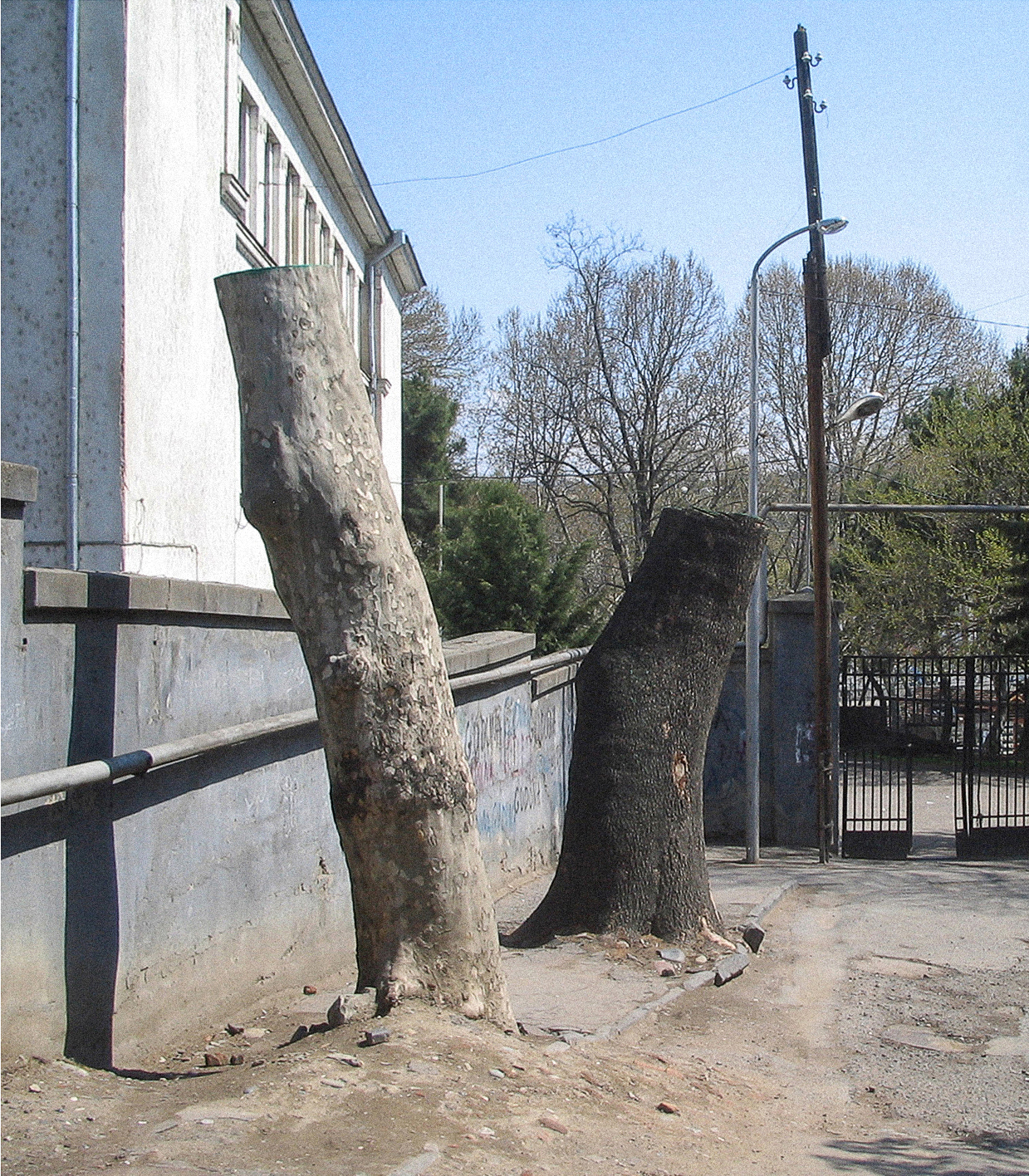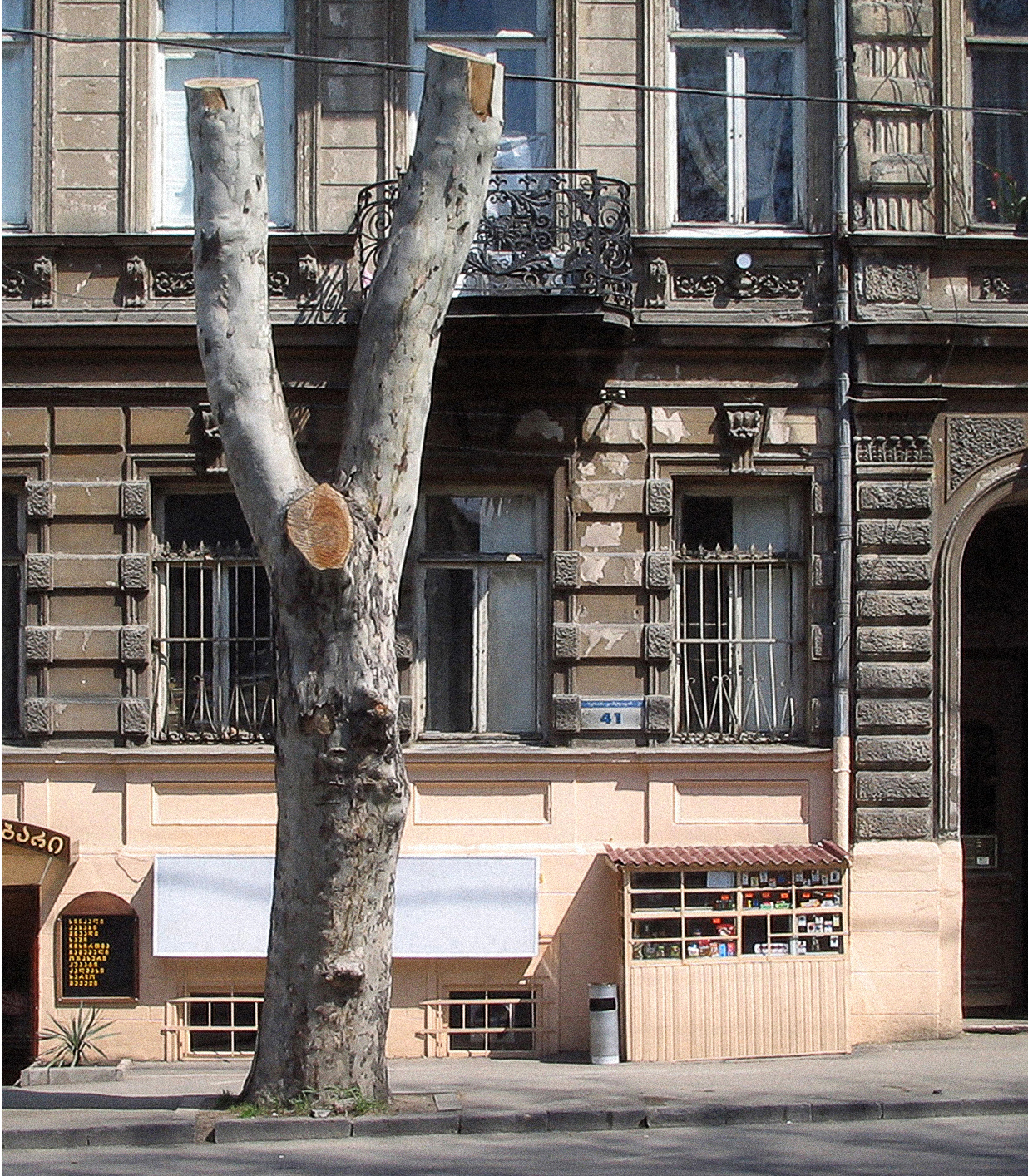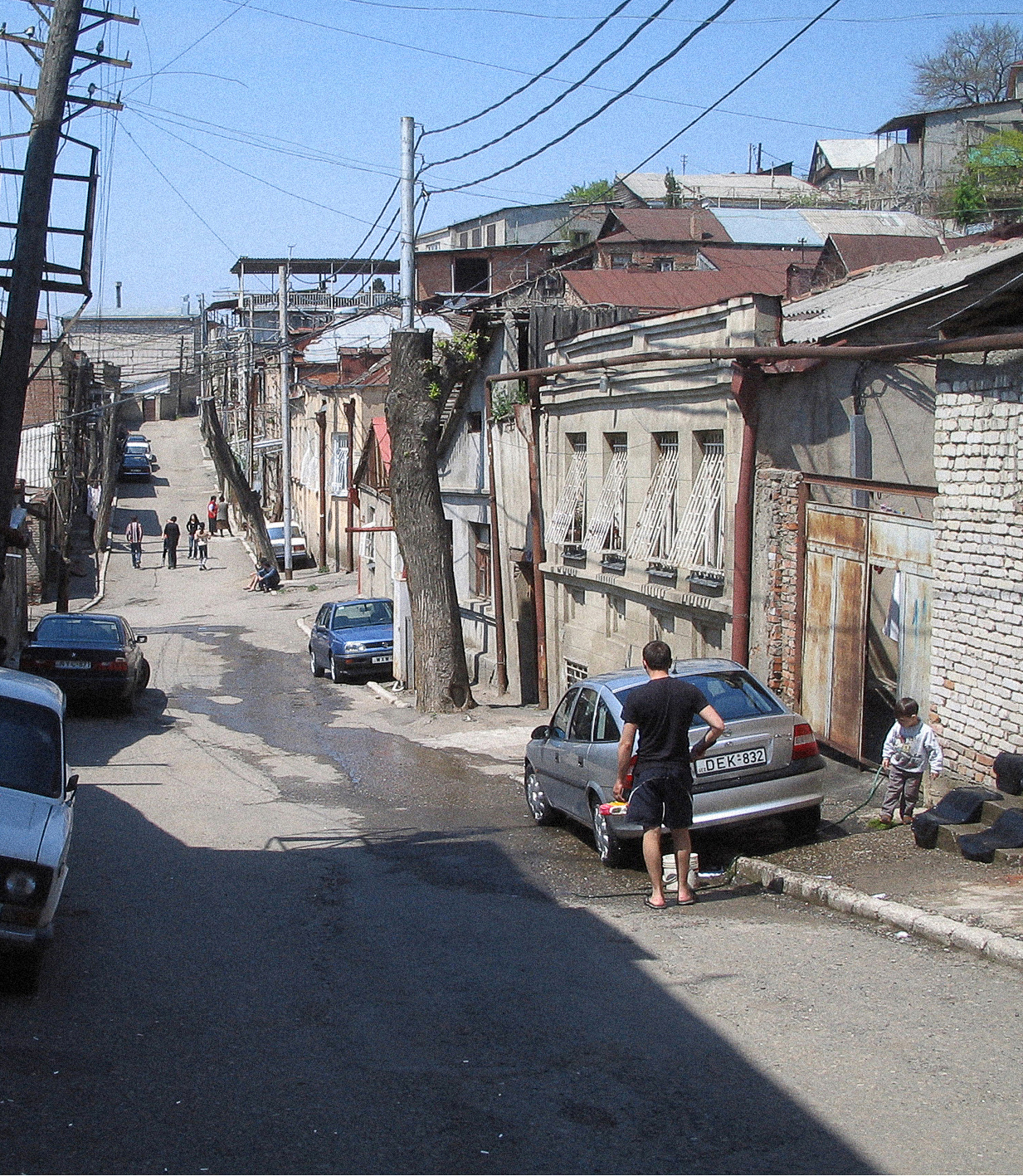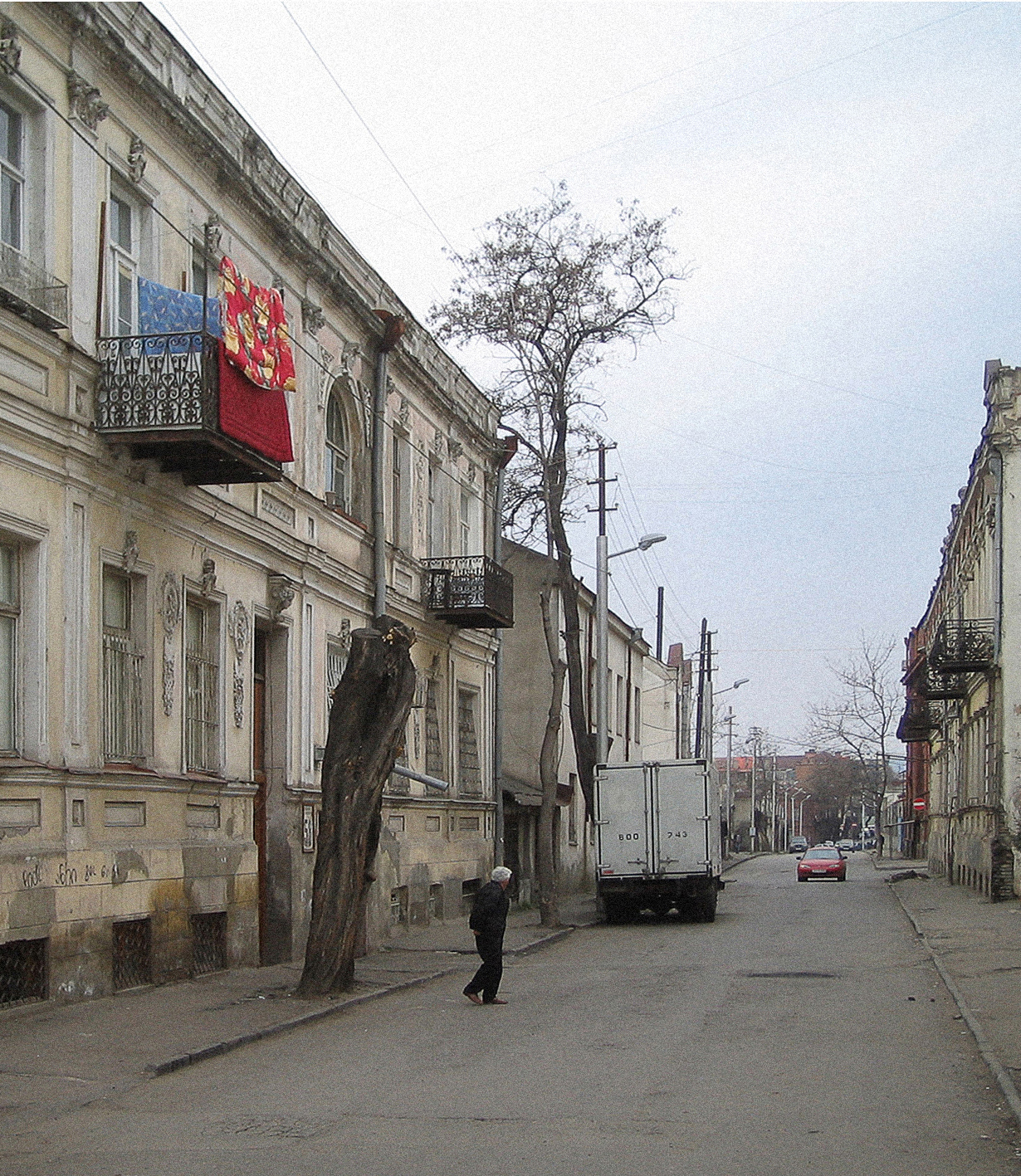The Pollarded Memory
December 2013
Subtitle:
or the semiotics of collective memories
Abstract:
In the spring of 2007, I stayed in Tbilisi for the first time at the invitation of Geoair. Out of all the impressions of that first time — which have become memories, fragments in my mind — one image still remains in my head. It seems to have been imprinted in my brain: the mutilated plane trees!

Of course, the average visitor cannot avoid looking at Tbilisi as an outsider, and during the first few weeks I wandered around like a tourist amongst the remnants of the Soviet era, many of them destroyed, half-collapsed and sometimes used for simple graffiti, such as band names from the West, the occasional swastika or tags from local youth.
Like everybody else, I made all the ‘obvious observations’, was seized by the beauty of the ‘informal architecture’ and the unique structures, and came up with ideas to apply this to contemporary urban planning. Just like everybody else. I chuckled at the flashy new national symbols of this state in the making. Characters were mixed with imported symbolism from the West. A tangle of visual language, with cross signs, red stripes, a white hand, currency, casinos and flags. Foreign icons were randomly appropriated, their original meaning often seemingly forgotten. The result was a cacophony, a real ‘cabaret Voltaire’ of characters and symbols.
A monument that was built on a square, a sculpture of a dragon slayer. What does it mean? The man, resembling a Roman emperor on a rearing horse, is frozen in time at the precise moment that he, almost in passing, delivers the fatal blow to the beast. The spear is stuck in the jaws of the beast, and it looks as if it was all just a casual occurrence in the dragon slayer’s day. I once came across Saint George in Barcelona and Lebanon, but I had never seen him portrayed as in Georgia. He was the replacement of Lenin, who had been standing here before him. The square had been renamed: Freedom Square. Freedom symbolised by a torturous death.
This grotesque new monument of Saint George turned out to be a gift from the sculptor Zurab Tsereteli, a man who is best ignored both politically and artistically, and whose pompous sculptures can be said to symbolize the arrogance and the abuse of the ruling powers. Power that is difficult to escape by dissidents, and power that takes an advantage of any situation, and just as easily transfers from one regime to the other. The circle is round: the dragon is the slayer and the slayer is the dragon, they are one and the same. This monument in Georgia in the capital definitely does not portray a holy man.
It did not end there; Tbilisi has an overkill of oddly used symbols with meanings that seem to have been reversed. It turned out to be perfect subject material to try and come up with personal interpretations. A euro sign is prominently displayed on the façade of a bank, but inside you can only exchange in Georgian lari or US dollars. The brand new and brightly lit Sameba cathedral, which towers over the city, was built quickly on an Armenian cemetery. One can only interpret it in one way: ‘subject yourself to your rulers’.
Servants of the church wore blue t-shirts with the flag of Europe, a symbol that actually has a catholic origin. In the Book of Revelation by John the Apostle, the Virgin Mary appears with a crown of twelve stars, and it is this sign that is casually worn by servants of the Orthodox Georgian church?
Priests show off their wealth and drive to and from the church in SUV’s. Perhaps it is a sign that the devil comes wearing a disguise? Unravelling the meaning of the symbols became my ‘thing’. At an exhibition for children’s drawings, a NATO sign was used as a symbol for peace, as some sort of spell. But the sign is a symbol of aggression and militarism. This had to be a mistake. The teacher at the primary school had mixed something up, and now the children could no longer tell right from wrong. Dangerous indeed, if one of these poor kids ever becomes a general and thinks his enemy is an ally. A future war would be lost before it even began. My brain went into overdrive and I became a symbolism junkie. Everything started to have an opposite interpretation and in the spring of 2007, I became addicted to symbols. In my head, the image of an Abkhazian flag, which a well-known controversial Georgian artist had painted over the national state symbol opposite of the buildings of parliament in the centre of Tbilisi, became a sign for the self-confidence of the Georgian people and not for animosity and occupation.

Going back to the beginning of all of this, one observation intrigued me in particular. The search for its meaning became a daily quest. Over and over I asked people why the trees in their city were truncated in such an extreme manner, the top cut off completely? That year, the old plane trees in the streets of Tbilisi had all been nearly cut in half. Not just one tree, but all of them, thousands in total, the entire top part removed. The neighbour on the patio next to where I was staying complained about no longer having the shade that the trees had provided and he missed the sound of the rustling leaves. People often explained that the fluffy seeds that come of the trees in spring were making the inhabitants of Tbilisi ill. After inquiring with a few experts in the Netherlands, I found out that this was highly unlikely. I received many indignant replies to the photos of mutilated trees that I attached to my e-mails.
“I don’t understand it either,” a man in the botanical garden told me, “the plane tree is actually the perfect, problem-free city tree, and definitely does not cause allergic reactions”. Others claimed that their hay fever had disappeared after the trees had been cut. And they thanked the president and his Dutch wife, Sandra. Because, people told me over and over, it had been Sandra who had had the trees cut. It was hard to imagine and I tried to picture such a thing happening in Paris or Amsterdam. All the trees in either city suddenly being cut in half one day, because the wife of the president had had a bad dream. If it was true that one person could order a mass execution of trees, without consulting any experts, then that meant I was in a dictatorship, no matter how well it was disguised as a new democracy. I saw a sign in the cutting of the trees; the sign of the guillotine. Independence of the judiciary is a prerequisite for democracy. But the civilians in Georgia have nowhere to go when it comes to real, independent justice, and are subject to the whims of those in power. The judges are not free. In Georgia, those who do not subject themselves to the power of the church or the state are in danger. Off with their heads. That was the sign.
None of my Georgian friends agreed with this interpretation.
“No, no way, it is much simpler,” my friends explained to me, “it is just an act of indifference. Someone started with it, for no particular reason. And no one took the effort to stop him”. All sorts of remarkable theories came up: “There had been a trader, who had made a deal.
He bought 100 saw blades for practically no money at all. The cousin of that man was a powerful politician and he managed to convince the city to buy all the saw blades from the trader, saying that they needed the blades. And so a few people had gotten very rich because of that deal. That is the only motive: personal enrichment.”
I kept believing in my own explanation. However, to this day, it is still somewhat of a mystery. When I returned to Tbilisi two years later, I had prepared myself for seeing all the maimed trees. But nothing could have been further from the truth. It was spring, sunny, and the trees were already beginning to sprout new leaves. Everything in the city was in bloom. A sign that nature encompasses all, life and death, the dragon and the slayer; the two sides of a coin.
Translated by:
Published:
This article appeared in December 2013 in a publication by the artist initiative GeoAir (Tbilisi, Georgia) that commemorated their 10-year anniversary.

